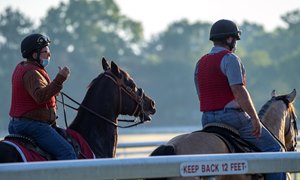OwnerView Conference: Safety Practices


At the Thoroughbred OwnerView National Owners Conference, held July 25 at Saratoga Race Course, veterinarians and racing executives discussed the progress made over the last two decades in safety for horses and jockeys and looked ahead to additional improvements on both the local and national levels.
Moderated by Shannon Luce, the director of communications for The Jockey Club, the Safety Practices panel began with Ann McGovern, director of racing safety for Horseracing Integrity and Safety Authority (HISA), offering an overview of the components of HISA's safety requirements and regulations.
These components include national standards for removing a horse from a veterinarian's list and voided claim rules; increased pre- and post-race testing of horses; universal track maintenance standards; and continuing education for a wide variety of racing personnel, including jockeys, outriders, starters, and track maintenance workers.
Appearing via teleconference, Dr. Susan Stover talked about how HISA will help to reduce equine injuries. A professor of surgical and radiological science at the University of California-Davis, Stover chairs HISA's Racetrack Safety Standing Committee and noted that 85-90% of catastrophic injuries in horses can be related to pre-existing injuries.
"This is an opportunity to prevent 85-90% percent of those deaths if we can detect minor injuries that predispose horses to catastrophic injury," Stover said.
That can be done, she said, through "increased collaboration" with trainers, observations during training and before and after races, and measurement of track surfaces.
"We're trying to find the ideal track surface so that we can engineer them to be kind to limbs."
As the senior vice president of operations and capital projects for the New York Racing Association, Glen Kozak has spent much of his tenure improving the maintenance and record-keeping of the organization's dozen track surfaces, comprising training tracks, pony tracks, dirt tracks, and turf courses.
"When I got here 13 years ago, we kept notes in a notepad. We wrote down the temperature, the weather, and wind speed. Now, we've got two weather stations here at Saratoga that monitor the wind every 15 minutes," Kozak said. "They record the temperature and evaporation. They enable us to monitor the environment for the horses and inform our maintenance of the track."
Dr. Stuart Brown was hired by Keeneland two years ago to serve as its vice president of equine safety. He said that Keeneland has built "an intimate program of monitoring and intervention" that includes contracts with trainers and the use of information from The Jockey Club's Equine Injury Database, which has identified various epidemiological factors as potential signals for injury risk factors.

Under the program, Keeneland has installed nine cameras across the main track and four across the synthetic training track.
"We can see horses from angles and perspectives that we never had before," Brown said.
As president of Grayson-Jockey Club Research Foundation, Jamie Haydon has overseen the organization's Welfare and Safety Summit and detailed that program's accomplishments since its inception in 2006. Those accomplishments include the Equine Injury Database, the Jockey Health Information System, the annual field day for track maintenance supervisors, and protocols for concussion management.
"The HISA recommendations are rooted in what's come out of the Safety and Welfare Summit," Haydon said.
While there has been an outcry from some quarters of the industry about the requirements under HISA, Kozak said the transition at NYRA tracks has been an "easy transition."
"There's always more to do, but the HISA safety requirements are based on what we've already been doing," he said.
